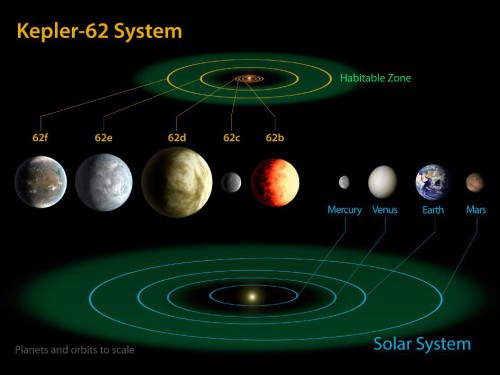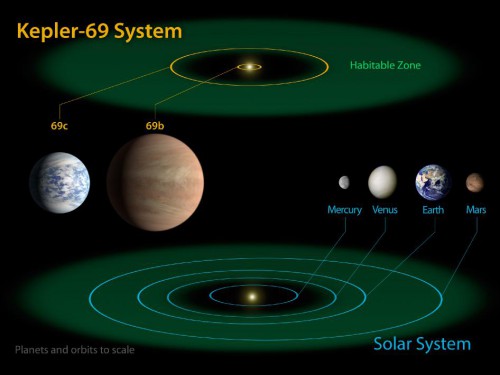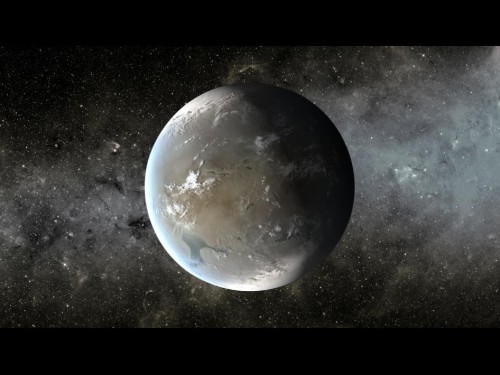
The Kepler Space Telescope has discovered two planetary systems that have worlds either within or near those stars’ “habitable zones.” Two of these worlds exist in the Kepler-62 system, with the third one orbiting just on the outside of this zone around its star, Kepler-69. The “habitable zone” is a term used by scientists to describe the region around a star where water can exist on the surface of a planet as a liquid. The announcement was made today from NASA’s Ames Research Center at Moffett Field in California at 2 p.m. EDT (11 p.m. PDT).
“We’ve always wondered how rare or how common planets like the Earth were in the galaxy,” said Kepler Project Manager Roger Hunter. “Until today, until today, Kepler had only announced two planets within the habitable zone—those being Kepler-22b and Kepler-47c, and both of them were relatively large. What we’re talking about today is two habitable systems, one harbors two habitable-zone planets and the other system has a planet just on the cusp of this zone.”

Image credit: NASA Ames/JPL-Caltech
As mentioned by Hunter, these worlds are not exactly similar to Earth—they are what is known as “super-Earths.” These worlds, while terrestrial, are larger than representatives within our solar system. The planets identified in the Kepler-62 system have been dubbed 62b, 62c, 62d, 62e, and 62f, with Kepler-62e, 62f, and 69c being the super-Earth-sized planets. Kepler-62f, one of the worlds within the habitable zone, is only 40 percent larger than Earth.
Both of the worlds “in the zone” around Kepler-62 are believed to be rocky, terrestrial worlds like Mercury, Venus, Earth, and Mars (researchers are unsure if one of these worlds is a “water” world).
The star that Kepler-62 orbits is a little smaller and cooler than our own Sun, being about two-thirds the size of our Sun and about one-fifth as luminous. It is also older than the Sun. Finding these planets is no easy feat.
“The detection and confirmation of planets is an enormously collaborative effort of talent and resources, and requires expertise from across the scientific community to produce these tremendous results,” said the Principal Investigator for the Kepler Mission William Borucki. “Kepler has brought a resurgence of astronomical discoveries, and we are making excellent progress toward determining if planets like ours are the exception or the rule.”

Most solar systems that we have discovered circling distant stars are very different than our own. Many have gas giants known as “Hot Jupiters” orbiting very closely to their parent star and making the likelihood of smaller, rocky worlds surviving within the habitable zone remote. Kepler-62, however, has a number of similarities to our own solar system, as it has (at least) five terrestrial planets orbiting their parent star.
Kepler is the first NASA mission capable of detecting potential Earth-like worlds in this crucial area around their parent stars. The Kepler spacecraft was launched from Cape Canaveral Air Force Station in 2009 atop a United Launch Alliance Delta II rocket. Since beginning its mission, Kepler has discovered more than 2,740 planet candidates.
“The Kepler spacecraft has certainly turned out to be a rock star of science,” said NASA Associate Administrator of the Science Mission Directorate John Grunsfeld. “The discovery of these rocky planets in the habitable zone brings us a bit closer to finding a place like home. It is only a matter of time before we know if the galaxy is home to a multitude of planets like Earth, or if we are a rarity.”

Researchers made sure to highlight that their ability to clearly determine the exact composition of these worlds is limited. However, new methods are being used to not only detect, but in some cases actually image these planets. For the researchers who spoke today, the growing capabilities of current spacecraft such as Kepler, along the prospects of what future missions might bring, signify that the best is yet to come.
“We only know of one star that hosts a planet with life: the Sun. Finding a planet in the habitable zone around a star like our Sun is a significant milestone toward finding truly Earth-like planets,” said Kepler Scientist Thomas Barclay.
Want to keep up-to-date with all things space? Be sure to “Like” AmericaSpace on Facebook and follow us on Twitter:@AmericaSpace




We are approaching that moment of breath -taking discovery when we find the “twin Earth.” It will confirm what we have suspected all along – that we are indeed not alone. The floodgates will be opened and we will have untold numbers of Earth-like planets that will keep scientists busy for millennia!